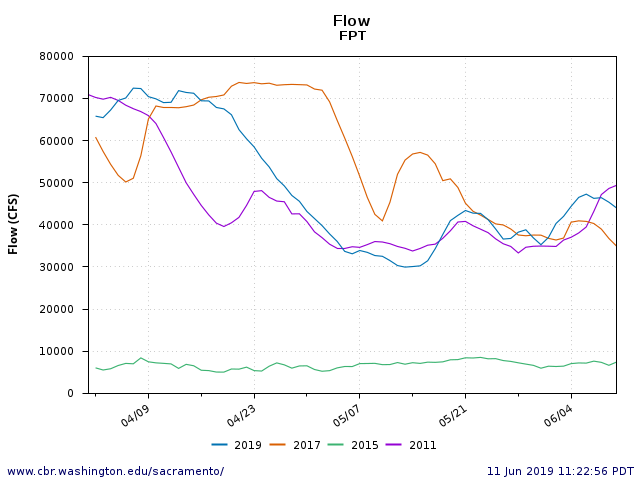The rivers flowing into the Delta are generally cool. The Bay is generally cool. But the Delta gets warm (>20oC, 68oF) from late spring into early fall. Rivers have a water quality standard limit of 68oF.1 The Delta should too.
Salmon, smelt, and steelhead are cool water fish that use the Delta for major portions of their life cycle. Water temperatures above 68oF are stressful, leading to poorer growth, higher predation, lower survival, and early exits from Delta critical habitats. One reason for the stress is that warmer water holds less dissolved oxygen. When water temperature exceeds 68oF, dissolved oxygen falls below 8 parts per thousand (ppt), which is stressful to fish. In eutrophic (high organic loads with lots of aquatic plants) waters like the Delta, dissolved oxygen can get even lower, near the minimum state standards (6-7ppt), especially at night.
Delta waters are cooler in wet years because of higher flows and generally cooler spring air temperatures. There is no doubt that low river inflows, higher exports, and low Delta outflows can exacerbate high Delta water temperatures, especially during hot periods of summer. There is also plenty of evidence that higher inflows, lower exports, and higher outflows during exceptionally warm weather can help minimize high water temperatures.
Delta waters are cooler when inflows are higher and cooler. The lower reaches of rivers that enter the Delta are cooler with higher flows. Maintaining high river inflows with the associated cooler water helps maintain Delta water temperatures. It takes approximately 20,000 cfs of Sacramento River inflow at Freeport to the Delta to maintain inflow water temperature near 68oF in summer (Figures 1-3).
The central Delta flow inputs are also cooler in late spring under higher Delta inflows, as exemplified by water temperature and flow comparisons between dry 2015 and wet 2011, 2017, and 2019 (Figures 4 and 5). This comparison dispels the argument that that water temperature in the Delta is wholly dependent on air temperature and is not affected by flow.
There is evidence that increasing diversions and decreasing flows in warmer weather (Figures 1 and 3) increases water temperatures. This is another reason to increase Delta river inflows during warm weather. A Delta water temperature standard/objective would potentially require episodic higher Delta inflows to offset higher warm weather diversions, in addition to a sustained inflow near 20,000 cfs in summer.

Figure 1. Water temperature and Sacramento River flow in summer 2016.

Figure 2. Water temperature and Sacramento River flow in summer 2017.

Figure 3. Water temperature and Sacramento River flow in summer 2018.

Figure 4. Water temperature in late spring in Georgiana Slough 2011, 2015, 2017, 2019.

Figure 5. Daily average flow in late spring in Sacramento River at Freeport 2011, 2015, 2017, 2019
